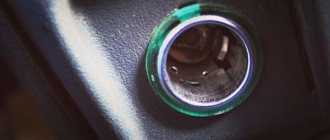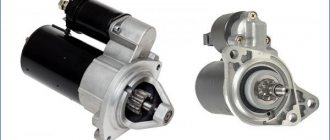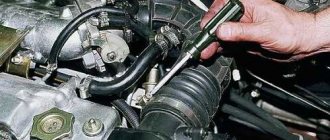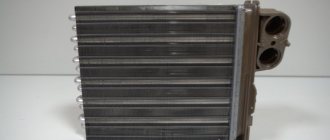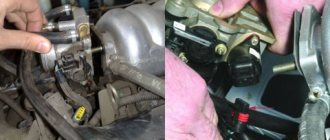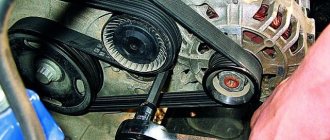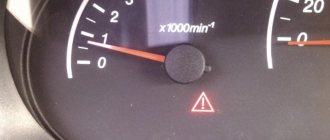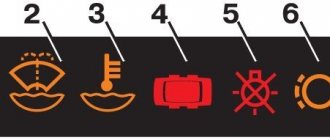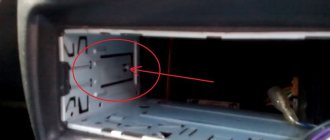Why does the radio sound?
There are several reasons why this problem may occur. The first of them is the occurrence of interference due to contact of the amplifier body with the body or unreliable antenna shielding. In this case, when listening to a radio station with a mediocre signal level, a squealing or crackling noise will be heard when the engine is running. If you press the gas pedal, the frequency of the strong background will increase in accordance with the engine speed.
The background often appears due to the induction of high-voltage discharges created by the ignition system of a gasoline engine. Also, the level of crackling noise from car media system speakers increases due to the use of low-quality high-voltage wires and faulty spark plugs. The cause of a monotonous squeak or squeal from the speakers may be a faulty generator. Interference provokes sparking brushes, worn commutator plates, and a short circuit in the stator winding.
Also, a strong background appears due to a malfunction of the radio, for example due to the drying out of the filter capacitor in the power circuit.
In this case, the radio freezes and reacts sensitively to all sources of interference in the car, including the DVR or radar detector.
Some media systems have a line wire fuse, which is placed between the ground on the board and the side terminals of the RCA sockets. When the negative wire of an amplifier connected in this way leaves, this fuse blows so that current does not flow through the interconnections of the radio.
In this situation, the linear outputs turn out to be ungrounded, which is why the radio sounds in any operating mode.
The interference is induced on the cables connecting the amplifier to the car radio. Other problems include loose connectors or damage to the screen shell. If there is strong interference when starting the engine, then the starter is to blame. Brushes can also spark in it.
What to do
First of all, all car radio wiring is checked for damage. If the antenna plug is not seated tightly, it should be removed and cleaned of dirt and oxides. If the screen shell of the radio frequency cable is damaged or torn, the plug must be re-soldered. If the background does not disappear, then the generator is checked for wear of the brushes and commutator.
If interference occurs when the engine starts, the starter is checked. Defective parts are replaced in all cases. The spark plugs and high-voltage wires should be checked. If breakdowns and cracks are detected, parts are replaced. Line output connections are also inspected, cleaned and crimped. Power circuits are checked for connection reliability.
Another way to solve this problem is to connect the radio to another point, for example directly to the battery. To replace the line output fuse, you can contact a service center. To eliminate the background, you need to follow a simple rule: you should not lay the car radio wires in the car next to the harnesses of the ignition and engine control systems.
Trouble. High-frequency whistle from speakers
There is a constant low-pitched, high-frequency whistle coming from the speakers in the car. As the engine speed increases, the whistle becomes louder and accordingly. at a higher frequency, if you don’t make the music louder, it’s very annoying; when you press on the gas, it’s like taking off on an airplane. There is still a small crackling sound, still audible.
I looked at the wiring and redid it. In theory, there can be no leads. Now: the wires of the power amplifier run in the center of the car, the acoustic ones along the sides, under the dashboard these wires, if they run side by side, are not parallel. Ground for the GU and for the amplifier: for each there are separate wires for plus and minus, and everything goes straight to the battery.
This suggests that the generator may be to blame. How can I check this? Pull off the alternator terminal with the car running for a short time and listen? If he is to blame, are there any filters on sale or something similar?
Could the power be to blame?
The crossovers are glued to the amplifier with double-walled tape. Maybe this is important.
P.S. Us - DLS CA-450, Hertz HSK-165 pancakes, Pio P88RS
How to get rid of noise and background in car speakers
Crosstalk, noise, and background noise when the engine is running are common problems not only for novice car audio enthusiasts. They may appear after the system is turned on for the first time, or they may appear completely unexpectedly - “Yesterday it didn’t happen, but today it appeared. I didn’t touch anything at all.”
The network is full of lengthy materials on how to find the cause and combat these unpleasant phenomena. Go through the checklist below and in most cases you will be able to solve the background or interference problem.
IMPORTANT! Carry out all switching on a de-energized system. Not just turned off, but de-energized.
A few words about subwoofers and why they are suitable for almost everyone
Subwoofers have long been an integral part of the lives of modern music lovers. But there are a great many prejudices regarding certain designs of subwoofers, their required number, frequency range, and in general the usefulness of this invention for humanity.
Connoisseurs, experts and simply “very knowledgeable people” often consider it preferable to use or not use certain technologies; others generally do not want to use separate low-frequency acoustics at all, because it does not kosherly correspond to ideas about the so-called. true AC. There are also people who are convinced that there should be 2 subwoofers (or more in terms of the number of playback channels); they even produce corresponding products for them.
In this material I will try to separate “flies” from “cutlets”, myths from reality, speculation from existing physical phenomena, in order to help our readers make the most appropriate choice. I will try to talk in detail about why subwoofers are suitable for almost everyone, and also touch on the issues of acoustic design and frequency range.
What to do
First of all, all car radio wiring is checked for damage. If the antenna plug is not seated tightly, it should be removed and cleaned of dirt and oxides. If the screen shell of the radio frequency cable is damaged or torn, the plug must be re-soldered. If the background does not disappear, then the generator is checked for wear of the brushes and commutator.
If interference occurs when the engine starts, the starter is checked. Defective parts are replaced in all cases. The spark plugs and high-voltage wires should be checked. If breakdowns and cracks are detected, parts are replaced. Line output connections are also inspected, cleaned and crimped. Power circuits are checked for connection reliability.
Another way to solve this problem is to connect the radio to another point, for example directly to the battery. To replace the line output fuse, you can contact a service center. To eliminate the background, you need to follow a simple rule: you should not lay the car radio wires in the car next to the harnesses of the ignition and engine control systems.
When the ignition is turned on, the radio on the car radio disappears
As a rule, this problem does not arise much at first. The radio hisses faintly only at high volumes; at low and medium volumes it is not annoying. Gradually, everything becomes more serious: as soon as the ignition is turned on, irritating noises and interference in the speakers begin to appear, nothing works. What can you do if the radio disappears when you turn on the ignition?
Additional options
If you are figuring out why the speakers started humming, but you haven’t noticed this before, apparently, it may be related to the sound card.
Using the standard Device Manager, try updating your sound card drivers, and if you are using speakers connected via USB ports, perform similar procedures for the corresponding controllers. Sometimes plugging the speakers into a different port helps. But if necessary, it’s also worth checking the ports themselves (in the sense of “checking” them).
Note: to make it easier for you to update your control software, it is better to use automatic update programs like Driver Booster.
Source
What is the problem?
To understand the problem in more detail, let’s look at how everything happens in detail:
- The ignition key is in position 0, and the music turns on (no interference, the radio does not disappear, everything works perfectly, no hiss);
- The key is turned half a turn and the ignition is turned on (interference begins, the radio disappears and appears, hisses);
- The key is turned a full turn, the engine starts (the noise increases, the radio may disappear completely if you press the gas pedal - the unpleasant hiss increases in proportion to the engine speed, the radio disappears or suddenly appears).
Messages [ 18 ] 854 [Closed]
1 Topic by Shel 10/01/2014 09:31:03 (4 years 10 months ago)
Topic: Why does the Subwoofer hum when the engine is running?
Plus it goes along one threshold, the rulers go along another, the car is turned off, everything is fine, you turn the music to 0, it hums in time with the engine. When you pull the tulips out of the radio, the buzzing stops, is it the problem with them or what?
2 Reply from Nikolay.Gofman 10/01/2014 09:32:02 (4 years 10 months ago)
Re: Why does the subwoofer hum in time with the running engine?
interference interferes. You need shielded wires
3 Reply from Dimorus 10/01/2014 09:34:23 (4 years 10 months ago)
Re: Why does the subwoofer hum in time with the running engine?
Plus it goes along one threshold, the rulers go along another, the car is turned off, everything is fine, you turn the music to 0, it hums in time with the engine. When you pull the tulips out of the radio, the buzzing stops, is it the problem with them or what?
4 Reply from Shel 10/01/2014 09:35:02 (4 years 10 months ago)
Re: Why does the subwoofer hum in time with the running engine?
Plus it goes along one threshold, the rulers go along another, the car is turned off, everything is fine, you turn the music to 0, it hums in time with the engine. When you pull the tulips out of the radio, the buzzing stops, is it the problem with them or what?
yes, only there is a hum in it
5 Reply from Dimorus 10/01/2014 09:36:30 (4 years 10 months ago)
Re: Why does the subwoofer hum in time with the running engine?
This means looking at the output path for a breakdown, the shielding is broken somewhere or there is no minus on the board, and that’s where electrical interference comes from the machine’s generator.
What kind of phone and car? You can try placing a capacitor in front of the sub, half a farad should be enough, if the sub is not very powerful, if the hum disappears, then good.
Reasons for radio loss
First of all, car owners begin to check the power cable. As a rule, it is routed on the left side of the driver, and the interconnect wires are routed on the right side. The speaker wiring, located on the left side of the car, is routed along with the power cable and radio antenna.
And indeed, if you mess up the connection of interconnect wires in the connectors, then noise and interference cannot be avoided.
Often the problem is caused by the subwoofer. If it is de-energized, everything returns to normal.
No exception is the power supply of the head unit. Again, incorrect connection of the speaker system. As a rule, the power cable should go to the amplifier separately, and the other power cable should go to the power unit separately, with the obligatory insertion of a fuse near the battery. And, of course, the car radio should be grounded to prevent interference.
If everything is fine with the wiring and interconnects, doubt automatically falls on the amplifier. It is quite possible that the rulers on the sound amplification device have burned out. It will help to check the installation of a known-good amplifier. If the noise disappears, then the only thing left to do is buy and install a new amplifier.
Grounding contours and installation recommendations
The fourth rule above states that one of the reasons why extraneous noise occurs in speakers is the presence of “ground loops.” Their presence in several places causes the generation of different voltages in individual parts of the vehicle body. This leads to additional noise.
The car body is essentially a large mass of metal that is used as a “ground” for electrical circuits. Its electrical resistance is minimal, but it is there. It has no effect on the operation of the electrical equipment of the vehicle itself, which cannot be said about the sound system. Since there are voltages of different potentials between points of the body, microcurrents arise, to which the filling of the speaker system is very sensitive.
To prevent the presence of audible noise, you should use the following rules:
I would also like to note that a good filter in the system is the presence of a capacitor.

